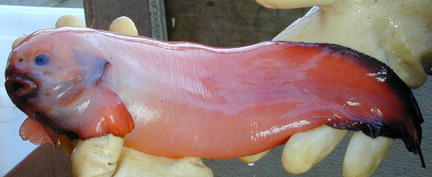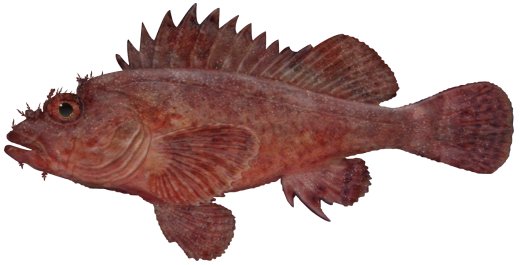Acho que é um "scorpaeoniforme", existem outras espécies com essas características de pouco músculo e aspecto gelationso, adaptações às altas (ou baixas?) profundidades:
"blobfish"


The blobfish (Psychrolutes marcidus)[1] is a fish that inhabits the deep waters off the coasts of the Australian mainland and Tasmania.[2] Due to the inaccessibility of its habitat, it is rarely seen by human beings. Blobfish are found at depths where the pressure is several dozens of times higher than at sea level, which would likely make gas bladders inefficient. To remain buoyant, the flesh of the blobfish is primarily a gelatinous mass with a density slightly less than water; this allows the fish to float above the sea floor without expending energy on swimming. The relative lack of muscle is not a disadvantage as it primarily swallows edible matter that floats by in front of it. It can be caught by bottom trawling with nets.
..."snailfish":

E o "lumpfish" ou "lumpsucker":

Mas eu mesmo nunca nem desconfiaria que esses dois aí são escorpioniformes se ninguém dissesse, o peixe que deve dar nome ao grupo, peixe-escorpião, é assim:

Muito mais "normal".
"Descobri" os mais esquisitos supracitados há uns anos atrás quando fui querer saber que peixe era um que vi na tv, cujas nadadeiras raiadas eram modificadas quase que simulando patas de artrópodes, sem a "membrana" entre os raios, e elas eram mais móveis:


Nesse vídeo é possível ver um usando as "pernas" no final:
<a href="http://www.youtube.com/v/ToDCeBWH5oE" target="_blank" class="new_win">http://www.youtube.com/v/ToDCeBWH5oE</a>Mas a filmagem que vi da primeira vez era mais impressionante, o animal mantinha as nadadeiras principais mais retraídas (e talvez fossem bem menores, não quase essas "asas" como desse aí), e se movia mais devagar com as patas, que também me pareceram ser bem maiores, mas talvez seja distorço da memória e/ou ângulo da câmera.